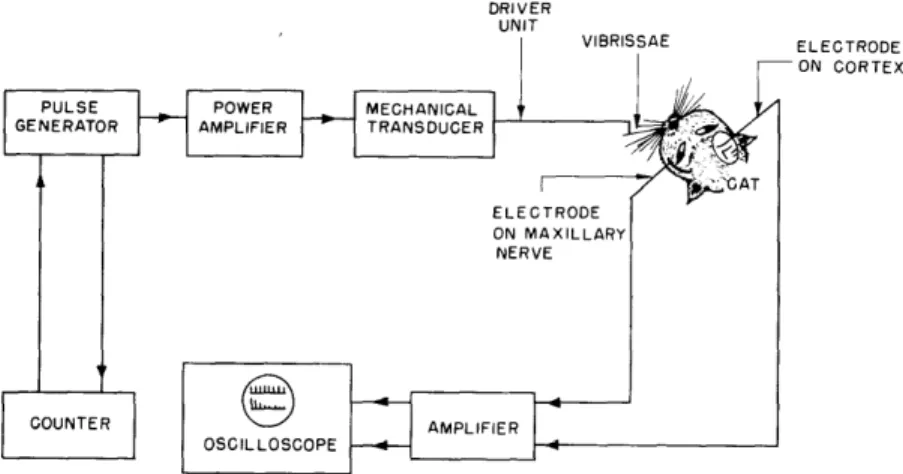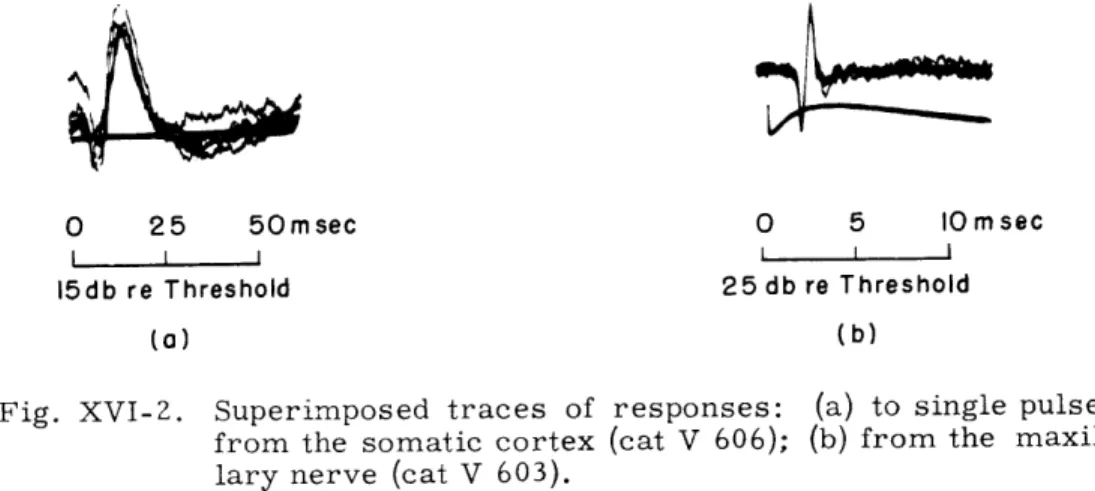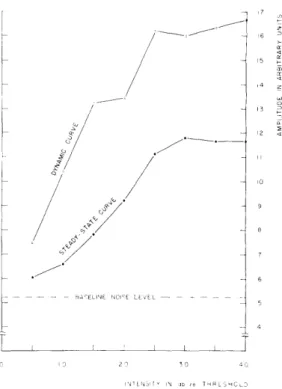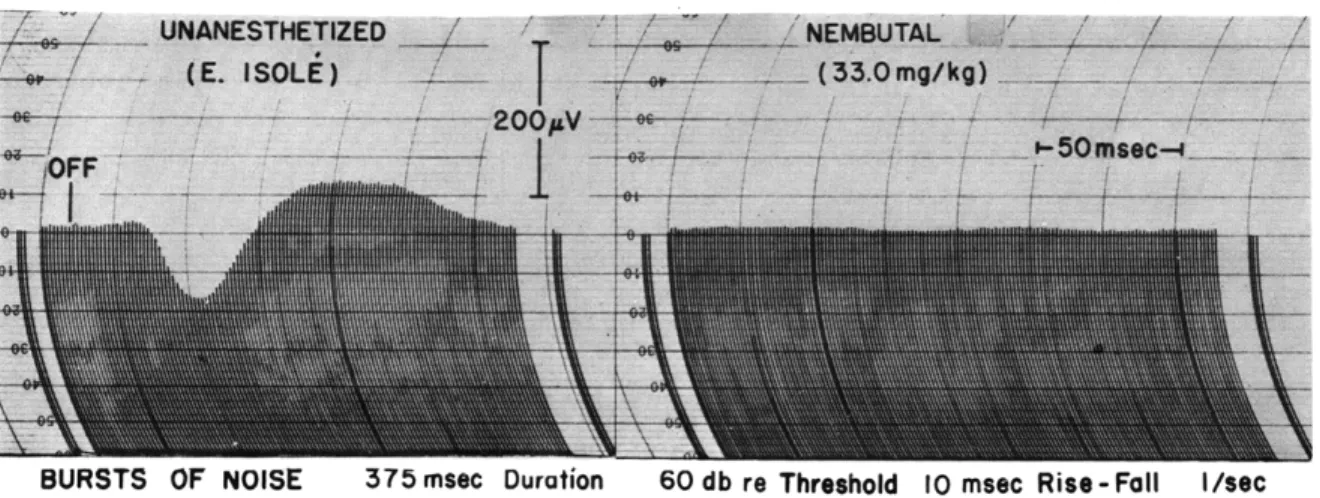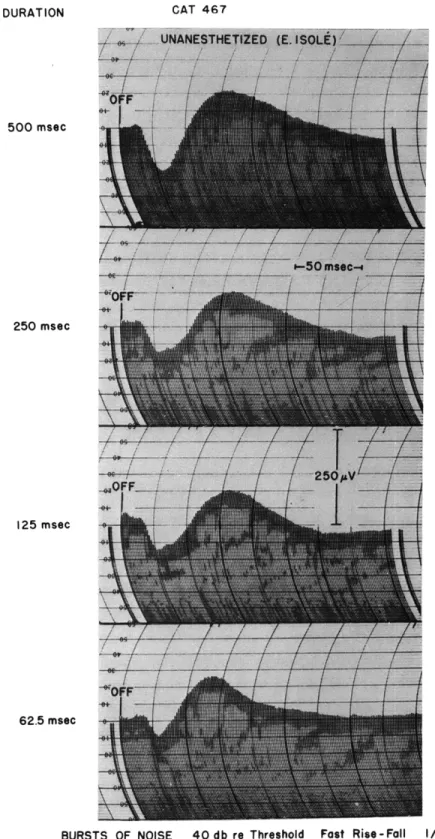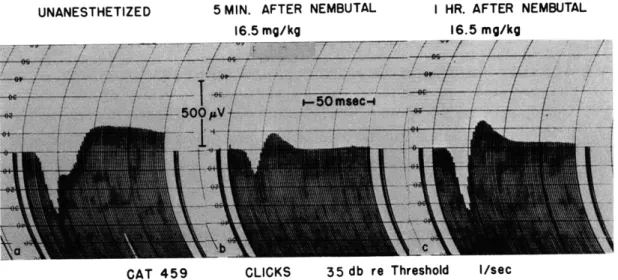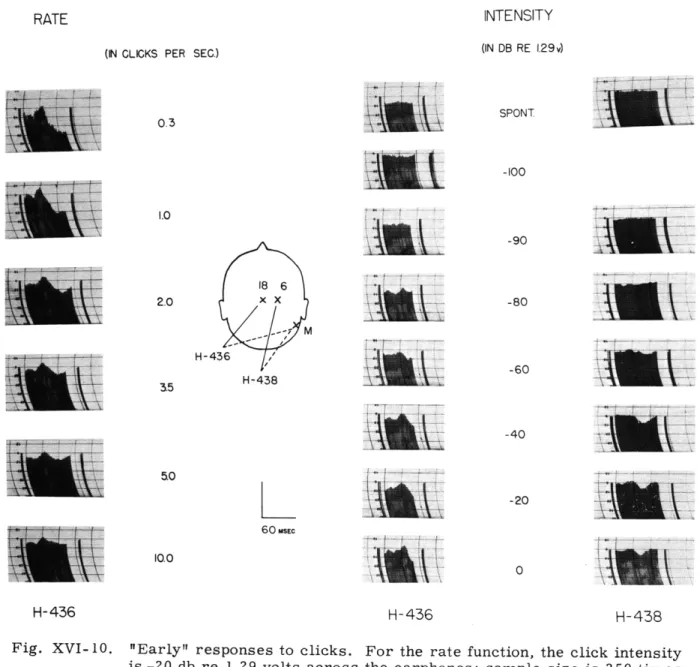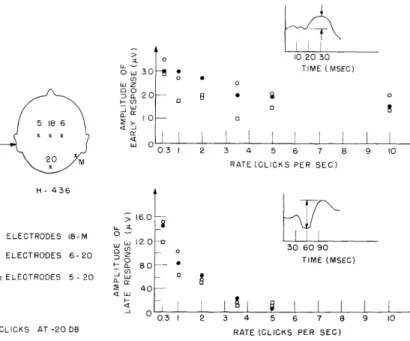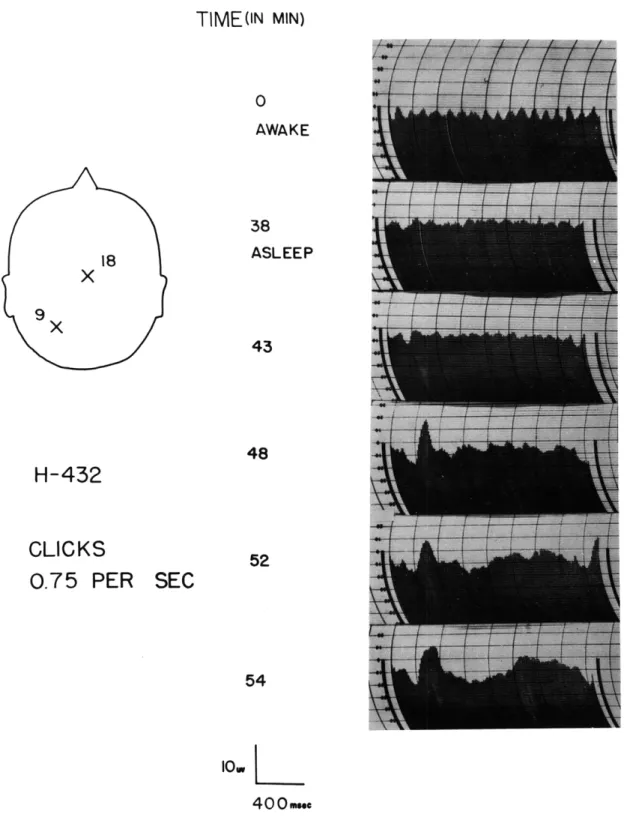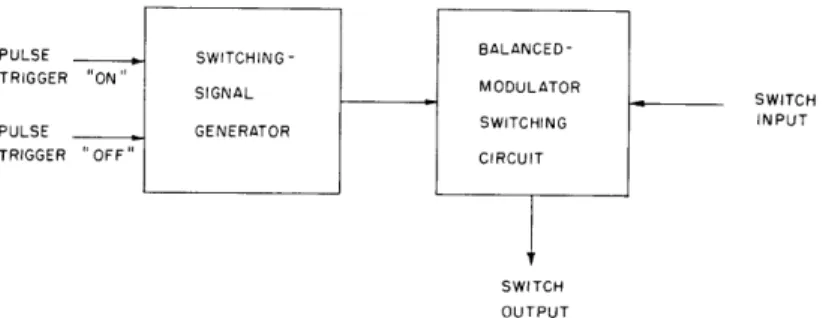XVI. COMMUNICATIONS BIOPHYSICS Prof. W. A. Rosenblith Prof. M. H. Goldstein, Jr. Dr. J. S. Barlow* Dr. M. A. B. Brazier"' Dr. E. de Boer Dr. L. S. Frishkopf Dr. F. J. Juliant Dr. Ursula O. Keidell Dr. W. D. Keidel . Dr. Melek Khairyl Dr. N. Y. S. Kiang Dr. T. T. Sandelff F. Amoroso R. M. Brown G. E. Forsen Mrs. M. Z. Freeman C. D. Geisler P. Nathan W. T. Peake R. J. Rosov
A. CORTICAL AND PERIPHERAL RESPONSES TO VIBRATORY STIMULATION OF THE CAT'S WHISKERS
Perception of touch and pressure is usually discussed in relation to a steady stimu-lus. There are few data on the responses of the somatic system to repetitive stimuli. Such stimuli permit the study of time patterns similar to the patterns that have been studied for the auditory system.
The somatic system differs from the auditory system in several respects:
somatic system
1. sensitivity to sinusoidal stimulation minimal energy displacement at threshold 2. frequency of maximal sensitivity (sinusoidal stimulation) 3. temperal resolving power 4. mechanical frequency resolution-2
10
-2-1
ergs (ref. 6)
3. 10- 5 cm (refs. 2, 5, 6) 200-300 cps (refs. 2, 5, 6) low no auditory system 4. 10 -112. 1 0 (ref. 1)-9
10- 9 (ref. 1) 2 kc (ref. 1) high (refs. 2, 3, 4, 6)yes (cochlea) (ref. 6)
Since the skin appears to be a more primitive system than the auditory system, it may be of interest to compare the electrophysiological responses of both systems in a search for generalizations that are valid for both systems on: (a) the time course of adaptation, (b) masking effects, and (c) the upper frequency limit of synchronized cortical responses to repetitive pulses. The purpose of the experiments reported here
From the Neurophysiological Laboratory of the Neurology Service of the Massachusetts General Hospital. TPostdoctoral Fellow in Neurophysiology of the National Foundation for Infantile Paralysis.
tVisiting Fellow, Electrical Engineering Department. Fellow in the School of Advanced Study.
(XVI. COMMUNICATIONS BIOPHYSICS)
DRIVER
UNIT VIBRISSAE
ELECTRODE ON CORTEX
PULSE
POWER
MECHANICAL
GENERATOR AMPLIFIER TRANSOUCER
CAT ELECTRODE
ON
MAXILLARY
NERVE COUNTER AMPLIFIER OSCILLOSCOPEFig. XVI-1. Block diagram of experimental apparatus. The driver unit is controlled by a power amplifier (18-watt output) that receives single pulses or trains of pulses from a pulse generator. The counter is preset for a certain number of pulses; every train is triggered manually by an external switch. The responses (peripheral and/or cortical) are amplified, and recorded from the oscilloscope screen by a Polaroid camera.
was to measure the peripheral and cortical responses to repetitive mechanical stimula-tion of the cat's vibrissae.
The cat's vibrissae on either the right or the left side were tied together with masking tape and fastened to the driving unit of a mechanical vibrator in such a way that pulses or sinusoidal waveforms delivered to the vibrator either pulled or pushed the vibrissae, according to the polarity of the stimulus (Fig. XVI-1). The maxillary branch of the ipsilateral fifth nerve and the contralateral cortex were exposed. Within that part of the primary somatic (S
)
region of the cortex that is just dorsal to the coronal sulcus responses can be evoked by stimulation of the vibrissae. Gross elec-trodes were placed in that region and on the maxillary nerve for recording responses at the cortical (Fig. XVI-2a) and first-neuron (Fig. XVI-2b) levels. Dial anesthesia was used in all cases. Since the vibrator generates sound, as well as vibration, both cochleas were destroyed in order to avoid sensory interaction effects.Intensity functions for peripheral and cortical responses to single pulses (duration, 0. 6 msec) cover a range of 25 db to 40 db re threshold. The apparent dynamic range can be changed by using a rubber ring to stabilize the skin surrounding the vibrissae (cat V 606; Fig. XVI-3). These ranges appear to be smaller than the dynamic ranges for the auditory system, particularly for the N1-response (approximately 100 db).
Stimulation of the vibrissae results in a compound action potential from the maxil-lary nerve; thus this response represents a group of fibers firing synchronously with a latency between 1. 5 msec and 2. 5 msec. This latency decreases with increasing stimulus intensity, paralleling the behavior of the NI-response of the auditory nerve
(XVI. COMMUNICATIONS BIOPHYSICS)
0 25 50msec 0 5 IOmsec
I I I I I I
15db re Threshold 25 db re Threshold
(a) (b)
Fig. XVI-2. Superimposed traces of responses: (a) to single pulses from the somatic cortex (cat V 606); (b) from the maxil-lary nerve (cat V 603).
(Fig. XVI-4, upper trace; cat V 603). The amplitude of the compound action potential increases with increasing intensity (Fig. XVI-4, lower trace); given the smaller dynamic range, the slope is much steeper than in the corresponding curves for the N1-response.
With trains of repetitive pulses (5/sec to 400/sec) we can study peripheral adapta-tion. Low repetition rates (up to 2/sec) do not change the amplitude of successive responses in a train; thus there is no adaptation. Adaptation within each train of stimuli in the form of a decrease of amplitude in the steady-state response begins at rates between Z/sec and 100/sec. For rates between 100/sec and 400/sec, wherein the peripheral responses are still synchronized with the stimulus frequency, only the first few (1-3) responses are larger in size than the adapted responses. This transition interval lasts only a few hundredths of a second.
The cortical intensity function (peak-to-peak amplitude against stimulus intensity) rises steeply for the first 20 db above threshold and then flattens out for the next 15 db. The latency of the surface-positive peak (approximately 5-7 msec) decreases with increasing intensity. With an increasing repetition rate, the amplitude of the cortical response drops until it is no longer visually detectable at rates between 50/sec and 70/sec.
At the cortex, the transition interval, at the end of which adaptation is practically complete, is much longer (up to 1. 5 sec) than at the level of the maxillary nerve. There is now a reason for defining the ratio
RA peak-to-peak amplitude of steady-state response R
A, 0 R peak-to-peak amplitude of initial response
In a train of pulses (presented at 10/sec) this ratio is largest for low levels of stimula-tion. Figure XVI-3 demonstrates that the slope of RA is much less than the slope of RI
(average of peak-to-peak amplitude for the first three responses). The RA curve corresponds to the steady-state condition and the R curve corresponds to the
,4 13 I5 12 tO 94 8
Fig. XVI-3. Latency and amplitude of peripheral responses against intensity. Each point represents an average of 5 values.
/7
Fig. XVI-4.
Intensity functions of cortical responses. Dynamic curve,
average amplitude of the first three responses in a train
of pulses (Rb).
Steady-state curve, average of last three
responses in a train of pulses (RA).
.B£OELINE INCFCE LEVE
r
s
L
(XVI. COMMUNICATIONS BIOPHYSICS)
dynamic condition of adaptation.
Trains of sinusoidal stimuli (60 cps) in lightly anesthetized animals produce cortical responses whose transition interval is of the order of 1. 5 sec. For a train delivered a few seconds after the end of the first train, there is no further adaptation; intertrain intervals of 5 minutes are necessary for complete recovery.
W. D. Keidel, Ursula O. Keidel, N. Y. S. Kiang
References
1. H. J. Autrum, Uber Energie- und Zeitgrenzen der Sinnesempfindungen, Naturwiss.
35, 361 (1948).
2. G. von Be'kesy, Uber die Vibrationsempfindung, Akust. Z. 4, 316 (1936).
3. G. von B6kesy, Human skin perception of traveling waves similar to those on the cochlea, J. Acoust. Soc. Am. 27, 830 (1955).
4. G. von B6k6sy, Sensation on the skin similar to directional hearing, beats and har-monics of the ear, J. Acoust. Soc. Am. 29, 489 (1957).
5. A. Hugony, Uber die Empfindung von Schwingungen mittels des Tastsinnes, Z. Biol.
96,
584
(1935).
6. W. D. Keidel, Vibrationsreception, der Erschuitterungssinn des Menschen, Erlanger Forschungen, Reihe B, Bd. 2 (Universitatsbund, Erlangen, 1956).
B. CORTICAL "OFF" RESPONSES TO BURSTS OF NOISE IN UNANES-THETIZED CATS
In a previous study (Quarterly Progress Report, Oct. 15, 1956, pp. 126-128), we
reported the presence of cortical responses time-locked to the decay of various tonal stimuli as the signals were turned off. The animals in these experiments were under Dial anesthesia. We noted then that "off" responses were found only when there was a marked change in the short-time spectrum of the stimulus as the signal was turned off. We concluded that these so-called "off" responses were in fact "on" responses to new sets of spectral components which fired neural elements that had been inactive during the period immediately preceding the "off" transient. This interpretation was strength-ened by the fact that bursts of noise, i. e., signals having a very broad spectrum, never produced the "off" responses that were so prominent with bursts of tone characterized by fast decay times.
In the present study we attempt to show that in unanesthetized cats (immobilized by a high spinal section) "off" responses are obtained under conditions in which the pres-ence of additional spectral components in the stimulus does not provide an explanation for the observed phenomena. Several considerations support this interpretation:
(a) "Off" responses are observed in unanesthetized animals when bursts of noise are turned off. These "off" responses can be completely eliminated by injecting even small dosages of nembutal into the femoral vein (Fig. XVI-5).
CAT 461
BURSTS OF NOISE 375 msec Duration 60 db re Threshold 10 msec Rise -Fall I/sec
Fig. XVI-5. Effects of intravenous nembutal on the "off" responses to bursts of noise. Each curve is the computed average of 300 responses to successive bursts. Each pen line represents a 1.25-msec time interval separation. Latency of the onset of the average "off" response is approximately 20 msec from the instant at which the fall of the noise burst begins. Recordings were made with con-centric bipolar electrodes in area II of the auditory cortex. Deflection above the zero-line represents surface negativity.
r.AT 4r7
BURSTS OF NOISE 40 db re Threshold 500 msec Duration I/sec
Fig. XVI-6.
"Off" responses to bursts of noise with different fall times. Each
curve is the computed average of 300 responses to successive
bursts. Latency of the average response changes from 14.0 msec
to 20 msec when the stimulus fall time is changed from "fast" to
10 msec.
Latency is measured from the lines labeled "OFF" on
the pen records.
DURATION
500 msec
250 msec
125 msec
62.5 msec
BURSTS OF NOISE 40 db re Threshold Fast Rise-Fall I/sec
Fig. XVI-7.
"Off" responses to bursts of noise of different duration. Each curve is
the computed average of 300 responses to successive bursts. Latency
of the average "off" response is approximately 14 msec.
_ _ ____ __ _C _~_ __
(XVI. COMMUNICATIONS BIOPHYSICS)
(b) Fall times of more than 10 msec fail to alter these "off" responses appreciably, except for latency, whereas the "off" responses to pure tones in anesthetized animals are found only when decay times are shorter than 2. 5 msec (Fig. XVI-6).
(c) When the duration of the noise burst is shortened to approximately 60 msec, the "off" responses in unanesthetized animals are still present (Fig. XVI-7). Bursts of tone of this same duration, characterized by fast rise and decay times, elicit no
"off" responses in unanesthetized animals.
(d) The latency of the "off" responses to bursts of noise, even for fast rise and fall times, is 6 msec to 8 msec longer than that of the corresponding "on" responses.
During this study special efforts were made to avoid producing the kinds of tran-sients described in the Quarterly Progress Report of October 15, 1956, page 127. Periodic checks showed that transients produced by the electronic switch alone, at the stimulus levels employed in these experiments, were below threshold for cortical responses.
N. Y. S. Kiang, T. T. Sandel
C. EVOKED CORTICAL RESPONSES AND ANESTHESIA
The waveform of evoked cortical responses recorded from cats that are anes-thetized with barbiturates is generally a large surface-positive component followed by a surface-negative component. In the present study we have compared the waveform of cortical responses to monaurally presented acoustic clicks before and after barbitu-rate anesthetization.
Cats were immobilized by high spinal sections. Concentric gross electrodes were placed in the primary auditory cortex (AI) with the sleeve on the surface of the cortex and the center electrode 2 mm below the surface. Electric activity was recorded by photographing oscilloscopic traces and by recording on magnetic tape.
Figure XVI-8 presents oscilloscopic traces of responses evoked by clicks presented at the rate of one per second. The three series were recorded (a) before anesthetiza-tion, (b) five minutes after injection of nembutal into the femoral vein, and (c) one hour later. The average of 300 responses for each of the above conditions was computed electronically (1). The average waveforms are shown in Fig. XVI-9. The responses in the unanesthetized animal show, in addition to the first surface-positive deflection, a second surface-positive deflection which we shall call the "notch." This notch occurs approximately 11-12 msec after the first surface-positive deflection in almost all cats and is sufficiently constant in latency so that the average response exhibits a clearly notched waveform.
UNANESTHETIZED
NEMBUTAL
16.5
mg/kg
T
400MLV
I
16.5 mg/kg
5Cn sec
i ----
i
CAT 459
CLICKS
35
db re Threshold
Fig. XVI-8.
Effects of intravenous nembutal on the configuration of the evoked
cortical responses.
The bottom trace in each set shows the
stimu-lus artefact.
Concentric electrodes were in the primary auditory
area (AI). Upward deflection represents surface negativity.
UNANESTHETIZED 5 MIN. AFTER NEMBUTAL I HR. AFTER NEMBUTAL
16.5 mg/kg 16.5 mg/kg
CAT 459 CLICKS 35 db re Threshold I/sec
Fig. XVI-9.
Effects of intravenous nembutal on the configuration of the averaged
evoked cortical responses.
Each curve represents the average of
300 responses to successive clicks.
The pictures are grouped so
that Fig. XVI-9a corresponds to Fig. XVI-8a, and so on.
I/sec
---~ -L- -~-~P----~---=-~-C
C~
ii~-(XVI. COMMUNICATIONS BIOPHYSICS)
relation to the position of the recording electrodes with respect to each other and to their location.
The changes in the evoked response following the intravenous injection of nembutal can be summarized as follows. Within a few minutes after the injection of nembutal, the notch disappears and the amplitude of the surface-positive component is decreased. Later, the positive peak gradually increases in amplitude until an hour later when the average amplitude may be even larger than that found before anesthetization. The aver-age amplitude remains at this level until the anesthesia begins to wear off. If the ani-mal recovers from anesthesia to the extent of exhibiting the eyeblink reflex, the notch reappears. Thus, to some extent, the effect of barbiturate anesthesia on the notch is reversible.
This notch has been observed by other workers in this laboratory (2). We have also found it in the records of other investigators who used comparable preparations (3).
N. Y. S. Kiang, M. H. Goldstein, Jr.
References
1. J. S. Barlow, An electronic method of detecting evoked responses of the brain and
for reproducing their average waveforms, EEG Clin. Neurophysiol. 9, 340-343 (May 1957).
2. M. A. B. Brazier, Studies of electrical activity of the brain in relation to anes-thesia, Neuropharmacology, Transactions of the First Conference (Josiah Macy, Jr. Foundation, New York, 1954), pp. 107-144.
3. F. Bremer, Les Aires Auditives de l'Ecorce Cerebrale, Cours International d'Audiologie Clinique (Imprimerie de Montligeon, Brussels, 1952), pp. 1-22.
D. THE "EARLY" RESPONSE TO CLICKS IN AWAKE SUBJECTS
Electrodes placed on the scalp of a human subject detect electric activity that is cerebral in origin. A method for the detection of responses to auditory clicks by means of an averaging technique was described by Barlow (1). Using this method we found, in addition to the commonly observed "late" response, an "early" response with an onset latency of about 20 msec (2). Further study of this early response and comparison of our results with the findings of other workers make it appear that it is related to the discharge of the specific afferent pathway to the auditory cortex.
Dawson (3, 4) found localized responses from the scalp to electric stimulation of the ulnar nerve. This response has an onset latency of 16-18 msec and is initially positive. Larsson (5) obtained similar results; in addition to the early response localized in the region over the somatosensory cortex, he found a later response of more diffuse origin which could also be evoked with auditory stimuli. Dawson sug-gested that the early response is related to the specific afferent discharge to the
(XVI. COMMUNICATIONS BIOPHYSICS)
somatosensory cortex, and Larsson identified the early component with the primary response. In another study Bates (6), recording from the scalp over the somatosensory area, reported a response beginning 20-35 msec after rapid hand movements, voluntary or electrically stimulated. Bates also suggested that this response is a primary somato-sensory effect. Cobb and Dawson (7) and Brazier (8) independently reported early responses to flash stimuli at latencies of 25-30 msec.
Recently, studies employing depth electrodes have been conducted on awake human patients (9). Responses to auditory clicks were recorded from electrodes in the posterior sylvian region. A surface-positive, highly localized response with an onset latency of approximately 20 msec was observed for click rates as high as 100 per second. A slower, more widespread response to individual clicks presented at a low rate was also recorded.
Results of Our Experiment. Figure XVI- 10 shows the average waveform of the early response to monaural clicks as a function of intensity and rate. The location of the electrodes is indicated. The left-hand column shows the behavior of the average response as the rate is varied from 0.3 to 10 clicks per second. The right-hand columns show -the average responses of two different subjects as a function of click intensity. Upward deflection in the graph indicates positivity at the electrode to which a solid line is drawn. The first peak that occurs consistently in the records indicates positivity near the vertex; the onset latency is approximately 20 msec; the peak latency is approximately 30 msec. It appears in a number of cases that a small nega-tive deflection precedes this peak.
The responses obtained by Dawson and by Larsson from the somatosensory cortex were localized, whereas the early responses that we observed are widespread over the scalp (see Fig. XVI- 11). When the depth of the auditory cortex beneath the skull is considered, however, the diffuse occurrence of the early response is not a serious obstacle to its interpretation as the result of a primary discharge.
It is interesting to compare, for a given subject, the psychophysical threshold with the click intensity at which a physiological response is first discerned. We find that the early response first appears at -90 db in subject H-436, and at -80 db in subject H-438. These values are in good agreement with the observed psychophysical thresholds of -90 db and -82 db, respectively.
In Fig. XVI-11 the amplitudes of the early response and of the late response (recorded simultaneously) are plotted as functions of click rate for various electrode pairs. The idealized waveform of the response and the amplitudes that were measured are shown in the insets. The late response disappears for rates higher than 5 per second, and in this respect exhibits the same behavior as the late response found by Larsson for electric stimulation of the ulnar nerve. The amplitude of the early response at a rate of stimulation of 10 clicks per second is still more than 50 per cent of its value
RATE
(IN CLICKS PER SEC.)
M
AA
H-436 H-438 60 MsEcH-436
INTENSITY
(IN DB RE 1.29v) SPONT -100 -90 -80 -60 -40 -20 0H-436
H-438
Fig. XVI-10.
"Early" responses to clicks. For the rate function, the click intensity
is -20 db re 1.29 volts across the earphones; sample size is 250 times
the click rate. For the intensity functions, the rate of presentation is 1 per second; sample size, 250. The indicated amplitude calibration is 10p.v
for H-436 and 20 [v for H-438. The zero-potential line is at -6 for H-436, and at zero for H-438. Upward deflection represents positivity at electrode 18 for H-436, and at electrode 6 for H-438._
---
3L~
II~
-
~---~-i
(XVI. COMMUNICATIONS BIOPHYSICS) o 10 20 30 S30 * TIME (MSEC) ,a 20 8 * 0 LU 0 H- 436 < O o ELECTRODES 18-M O , 0 30 60 90 * ELECTRODES 6-20 3 60 M0 - 80 --SELECTRODES 5- 20 Z0 4.0 0.3 2 3 4 5 6 7 8 9 10
CLICKS AT -20 DB RATE (GCLICKS PER SEC)
Fig. XVI-11. Rate functions for the "early" and "late" components of the response. Top graph, amplitude of the early response as a function of the click rate. Bottom graph, amplitude of the late response as a function of the click rate. Each point on the graph is taken from the corre-sponding average waveform. Click intensity, -20 db re 1. 29 volts across the earphones.
at a rate of 0. 3 clicks per second. The contrasting behavior of the early and late responses as a function of rate indicates rather strongly that they have different origins.
C. D. Geisler, L. S. Frishkopf, R. M. Brown References
1. J. S. Barlow, An electronic method for detecting evoked responses of the brain and for reproducing their average waveforms, EEG Clin. Neurophysiol. 9, 340-343
(1957).
2. Quarterly Progress Report, Research Laboratory of Electronics, M. I. T., Jan. 15, 1957, pp. 123-126.
3. G. D. Dawson, Cerebral responses to electrical stimulation of peripheral nerve in man, J. Neurol., Neurosurg. and Psychiat. 10, 134-140 (1957).
4. G. D. Dawson, Cerebral responses to nerve stimulation in man, Brit. M. Bull. 6, 326-329 (1950).
5. L. E. Larsson, Electroencephalographic responses to peripheral nerve stimulation in man, EEG Clin. Neurophysiol. 5, 377-384 (1953).
6. J. A. V. Bates, Electrical activity of the cortex accompanying movement, J. Physiol. 2-3, 240-257 (1951).
7. W. Cobb and G. D. Dawson, The form and latency in man of the occipital potentials evoked by bright flashes, Abstracts of Communications, XXth International Physio-logical Congress, Brussels, 1956, p. 182.
(XVI. COMMUNICATIONS BIOPHYSICS)
8. M. A. B. Brazier, Studies of responses evoked by flash in man and cat, Inter-national Symposium on the Reticular Formation of the Brain, Henry Ford Hospital, Detroit, 1957 (in press).
9. C. W. Sem-Jacoben, M. C. Petersen, H. WV. Dodge, Jr., J. A. Lazarte, and C. B. Holman, Electroencephalographic rhythms from the depths of the parietal, occipital, and temporal lobes in man, EEG Clin. Neurophysiol. 8, 263-278 (1956).
E. DEVELOPMENT OF THE K-COMPLEX WITH SLEEP
In 1939, P. A. Davis (1) reported that auditory stimuli delivered to awake human subjects evoke electric responses that can be detected by scalp electrodes. A similar response, evoked in light sleep, was found by Davis and others (2) and named the K-complex. In a recent paper, Roth, Shaw, and Green (3) reported that the K-complex
was evoked in all subjects in light sleep. They were not able to obtain the response in deep sleep.
We conducted an investigation of the average waveform of the K-complex as a human subject fell asleep. In a previous report we described similar work in which awake subjects were studied (4). The technique for obtaining average responses has been described by Barlow (5).
Figure XVI-12 shows the progressive behavior of the average waveform as the sub-ject fell asleep. Each curve represents the average of the responses to 175 consecutive
clicks presented at a rate of 0. 75 per second. The elapsed time of the experiment is indicated. The electrode locations are shown; an upward deflection indicates negativity at electrode 18 with respect to electrode 9.
When the subject was awake, with eyes closed, no K-complex was observed. Thirty-eight minutes after the beginning of the experiment, the general activity of the brain waves first indicated that the subject had fallen asleep. At this time, the K-complex
was just discernible, and the a-rhythm, clearly present at earlier times, was greatly diminished. As the experiment progressed, the K-complex became larger and more
clearly defined. At 54 minutes the response seemed to have reached a stable waveform, since the response 12 minutes later showed no change. Unfortunately, the subject awakened at this point in the experiment.
C. D. Geisler, L. S. Frishkopf
References
1. P. A. Davis, Effects of acoustic stimuli on the waking human brain, J.. Neuro-physiol. 2, 494-499 (1939).
2. H. Davis, P. A. Davis, A. L. Loomis, E. N. Harvey, and G. Hobart, Electrical reactions of the human brain to auditory stimulation during sleep, J. Neurophysiol.
TIME(IN
MIN)
0
AWAKE
38
ASLEEP
43
H-432
CLICKS
0.75 PER
Fig. XVI-12.
Development of the K-complex in sleep.
Stimulus, a
medium-intensity click delivered binaurally.
The zero-potential line
is at approximately -5.
In the two lower graphs the amplitude
is reduced by a factor of approximately 3.
48
SEC
52
54
I40
400ee
__ ---
~m~----_a_
IC ~~
-
---_)---=--LPL-(XVI. COMMUNICATIONS BIOPHYSICS)
3. M. Roth, J. Shaw, and J. Green, The form, voltage, distribution and physiological significance of the K-complex, EEG Clin. Neurophysiol. 8, 385-402 (1956).
4. Quarterly Progress Report, Research Laboratory of Electronics, M. I. T., Jan. 15, 1957, pp. 123-126.
5. J. S. Barlow, An electronic method for detecting evoked responses of the brain and for reproducing their average waveforms, EEG Clin. Neurophysiol. 9, 340-343 (1957).
F. ELECTRONIC SWITCH FOR STUDIES OF THE AUDITORY SYSTEM
An electronic switch, used to produce stimuli signals for auditory research, was designed and tested. The switch is externally triggered both "on" and "off" so that the experimenter can easily control the rate and the duration of the switching process. The maximum burst rate attainable with the present design is 20, 000 per second. The rise and fall times of these bursts may be independently varied in 12 steps from 15
psec
to 500 msec. Three easily adjustable balancing controls allow the switching transient, inherent in such a device, to be reduced to 40 db below the output-signal level.Figure XVI-13 is a block diagram of the switch. The switching circuit consists of cascoded triodes, used in a balanced modulator design. Varying the dc grid bias on the upper tube of each stage allows the experimenter to change the characteristics of the two stages, in order to make them more nearly identical over the entire operating range.
A bistable multivibrator, two RC integrators, and a clipping circuit compose the switching-signal generator. The resistors in the RC integrators are diode-shunted so that they will affect only the leading or trailing edge of the switching signal. The shaped wave is then clipped at two levels to provide a portion of the waveform for which the rise and fall intervals are quite linear.
The switch input is push-pull-coupled to the switching circuit; the switching signal
PULSE _ SWITCHING - BALANCED-TRIGGER ON" SIGNL MODULATOR
SWITCH
PULSE GENERATOR SWITCHING INPUT
TRIGGER OFF" CIRCUIT
SWITCH
OUTPUT
